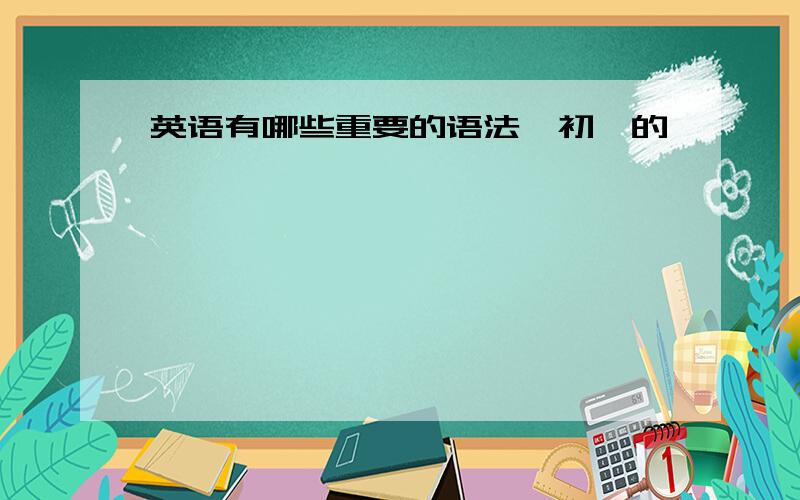英语有哪些重要的语法【初一的】
来源:学生作业帮 编辑:神马作文网作业帮 分类:英语作业 时间:2024/11/11 11:27:44
英语有哪些重要的语法【初一的】

介词与名词、形容词、动词等搭配的习惯用法 介词与名词、形容词、动词等搭配的习惯用法 (1)与名词搭配,如:at midnight 在午夜,at the head of 在……的前头,in the future 将来,in the end 最后,等; (2)与形容词搭配,如:be angry with 对(某人)生气,be afraid of 害怕,be proud of 以……自豪,等; (3)与动词搭配,如:catch up with 赶上,laugh at 嘲笑,agree with 同意……的意见,arrive in/at 到达,等; (4)其他搭配,如:instead of 代替,make room for 给…腾地方,be fed up with 厌倦,from now on从现在开始,等. 考例再现: 1.______ the help of my teacher, I caught up with the other students. A. Under B. In C. With D. On (C) 2.Hawaii is famous ____ its beautiful beaches. A. for B. in C. of D. with (A) 3.He has got a chair to sit _____, but nobody to talk ___. A. on; to B. 不填; with C. on; 不填 D. 不填; to (A) 4.—You’d better not go out now. It’s raining. —It doesn’t matter. My new coat can keep ___ rain. A. in B. of C. with D. off (D) 5.Mary is flying to France soon. She will arrive _____ Paris _____ the morning of July 9. A. at; in B. in; on C. in; in D. at; on (B) 1. 人称代词 主格: I we you she he it they 宾格: me us you her him it them 形容词性物主代词:my our your her his its their 名词性物主代词: mine ours yours hers his its theirs 2.形容词和副词的比较级 (1) 一般在形容词或副词后+er older taller longer stronger, etc (2) 多音节词前+more more interesting, etc. (3) 双写最后一个字母,再+er bigger fatter, etc. (4) 把y变i,再+er heavier, earlier (5) 不规则变化: well-better, much/many-more, etc. 3.可数词的复数形式 Most nouns + s a book –books Nouns ending in a consonant +y - y+ ies a story—stories Nouns ending in s, sh, ch or x + es a glass—glasses a watch-watches Nouns ending in o +s or +es a piano—pianos a mango—mangoes Nouns ending in f or fe - f or fe +ves a knife –knives a shelf-shelves 4.不可数名词(单复数形式不变) bread, rice, water ,juice etc. 5. 缩略形式 I’m = I am you’re = you are she’s = she is he’s = he is it’s = it is who’s =who is can’t =can not isn’t=is not etc 6. a/an a book, a peach an egg an hour 7. Preposition: on, in ,in front of, between, next to, near, beside, at, behind. 表示时间: at six o’clock, at Christmas, at breakfast on Monday on 15th July On National Day in the evening in December in winter 8. 基数词和序数词 one – first two-second twenty-twentieth 9. Some /any I have some toys in my bedroom. Do you have any brothers or sisters? 10. be 动词 (1) Basic form: am/are/is (2) 肯定和否定句 I am(not) from London. My eyes are(not) small. My hair is(not) long. (3)一般疑问句: Am I a Chniese? Yes, you are. No, you aren’t. Are they American? Yes, they are. No, they aren’t. Is the cat fat? Yes, it is. No, it isn’t. 11. there be 结构 肯定句: There is a … There are … 一般疑问句:Is there …? Yes, there is./ No, there isn’t. Are there…? Yes, there are. /No, there aren’t. 否定句: There isn’t …. There aren’t…. 12. 祈使句 Sit down please Don’t sit down, please. 13. 现在进行时.通常用“now”. 形式: be + verb +ing eg: I am(not) doing my homework. You/We/They are(not) reading. He/She/It is(not) eating. 动词—ing 的形式 Most verbs +ing walk—walking Verbs ending in e -e + ing come—coming Short verbs ending in a vowel + a consonant run –running swim—swimming 14 一般现在时.通常用 “usually, often, every day, sometimes”. 形式: 肯定句: I go to school on foot every day. She goes to school on foot every day 一、一般现在时 ★ 一般现在时指经常性或习惯性的动作或状态,常和often, usually, always, sometimes, every…等时间状语连用.肯定句谓语动词用动词原形(单三+s), 否定句用don’t /doesn’t +动词原形,疑问句用Do/Does…+动词原形? e.g. Tom does his homework every day. 汤姆每天都做家庭作业. 否定句:Tom doesn’t do his homework everyday. 汤姆每天都不做家庭作业. 疑问句:Does Tom do his homework everyday 汤姆每天都做家庭作业吗? Yes, he does./No, he doesn’t. 是的.(不,不做.) 二、现在进行时 现在进行时的基本用法 1.表示说话时正在进行的动作 常和now 连用,有时用一个look、listen ,来表now 这一时间概念. *Look! A train is coming .看,火车来了. *Listen! He is playing the piano.听,他在弹琴. 2.表示现阶段正在进行的动作 但不一定是说话时正在进行.常和at present ,this week ,these days…等时间状语连用. *What lesson are you studying this week?你们本周学哪一课了?(说话时并不在学)